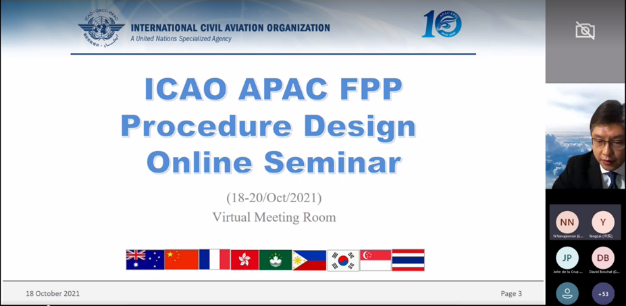To be able to accelerate the implementation of Performance Based Navigation (PBN), thereby realizing the significant safety, access, efficiency, and reduced environmental impact benefits of PBN, a group of Civil Aviation Administrations in the Asia-Pacific Region, including the Civil Aviation Administration of China (CAAC) as the host State, with the assistance of ICAO, established the Flight Procedure Programme (FPP) in 2010.
The objective of this programme, which is funded by the active participating States/Administrations of Australia, China (People’s Republic of, Hong Kong SAR, and Macao SAR), France (French Polynesia), Philippines, Republic of Korea, Singapore, Sri Lanka and Thailand and co-located with the ICAO APAC Regional Sub-Office in Beijing, is to assist States to develop sustainable capability in the instrument flight procedure (IFP) domain/ This enables them to meet their commitments under Assembly Resolution A36-23 for performance-based navigation (PBN) implementation and their obligations for the quality of their IFPs. The Democratic People’s Republic of Korea, Fiji, Mongolia, Myanmar, Pakistan, Tonga and Viet Nam participate in the programme as users, not contributing States.
 In support of efforts to provide States/Administrations with a platform for enhancing the communication for application of PBN flight procedure among the flight procedure designer, regulator, ATM manager and other relevant entities, FPP Procedure Design online Seminar(PD seminar) was conducted on 18-20 October 2021 with strong engagement from 110 participants representing 18 States. It was the third event in a series of seminars on flight procedure design in the APAC region since 2019, with the largest number of participants.
In support of efforts to provide States/Administrations with a platform for enhancing the communication for application of PBN flight procedure among the flight procedure designer, regulator, ATM manager and other relevant entities, FPP Procedure Design online Seminar(PD seminar) was conducted on 18-20 October 2021 with strong engagement from 110 participants representing 18 States. It was the third event in a series of seminars on flight procedure design in the APAC region since 2019, with the largest number of participants.
With its “everyone can be a speaker” slogan, the Procedure Design seminar is a popular platform for flight procedure designers from all APAC states to interact with each other rather than with experts. Eight speakers from China, India, Maldives, Nepal and New Zealand shared their experiences of real cases regarding RNP-AR, RNP-1, ILS CAT III, EoR, obstacle assessments and wind spiral. Sharing content from both domestic applications and personal innovations provides participants with a fresh perspective and different ideas. Participants raised more than 50 questions daily in the Q&A session. Many members of the audience also expressed their desire to be speakers in the next PD seminar.
Information on the webinar and additional topics can be found here.
